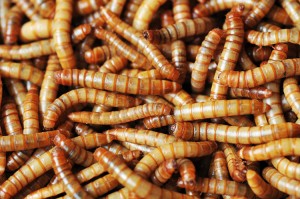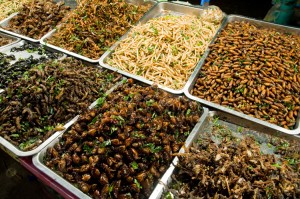Mealy Meals in Switzerland
September 14, 2017
Last month, Switzerland became the first European Union (EU) country to allow the sale of insect-based food items for human consumption. That’s right, for those of you craving a mealworm burger or a side of crickets or grasshoppers, you can now get them at the local market in Bern, Geneva, or Zürich. Long accepted as a protein-rich food in other parts of the world, eating insects is relatively new to Europeans, who—like a lot of other people—have a hard time getting over the “yuck” factor of eating bugs. Insects, however, are a logical, practical, and even tasty food choice as human populations continue to rise along with the economic and environmental cost of raising traditional crops and livestock.

Mealworms (the grubs of a type of darkling beetle) may be new to the diet of many people, but they have long been used in animal feed. Credit: © Denis Tabler, Shutterstock
In Africa, Asia, and parts of Latin America, it is common to find insects on menus or for sale in markets. In the United States, insects can be found as exotic menu items, and they are often used as food additives or dyes. U.S. companies can sell whole insects as long as the bugs are clean, wholesome, and raised specifically for human consumption. Most Food and Drug Administration (FDA) laws, however, detail limits of “unavoidable” bugs in other food. Chew on that for a minute. Anyway, in Europe, the Novel Food Regulation limits food that was not “used for human consumption to a significant degree” before 1997. This means that nontraditional food items must get special legal clearance. In May 2017, Switzerland approved crickets, grasshoppers, and mealworms as food items, and after the EU agreed, bugs hit store shelves in August.

A wide variety of prepared insects are available for snacking at this market in Thailand. Credit: © Thor Jorgen Udvang, Shutterstock
Not all insects are fit for human consumption, of course, but many provide a highly nutritional, readily available, and environmentally friendly food source. Traditional agriculture—the planting and harvesting of crops, the raising of livestock, and the transport and delivery of food items—is a heavy contributor to global warming, which in turn adversely affects traditional agriculture. To slow the impact of climate change, and to feed the world’s ever-growing human population, insect agriculture is a logical and practical choice. Aside from Switzerland’s new food items, such insects as ants, bees, beetles, caterpillars, and locusts are packed with protein, fiber, good fats, and vital minerals. Bugs require much less feed, space, and care than traditional farm animals. They also emit considerably fewer greenhouse gases than most livestock.
Insects can be quite tasty, too. After all, they are arthropods, the largest phylum (division) of the animal kingdom that also includes crabs, lobsters, and shrimp. Most animals and many people on Earth already indulge in entomophagy (insect eating). Is it about time the rest of us joined them?


